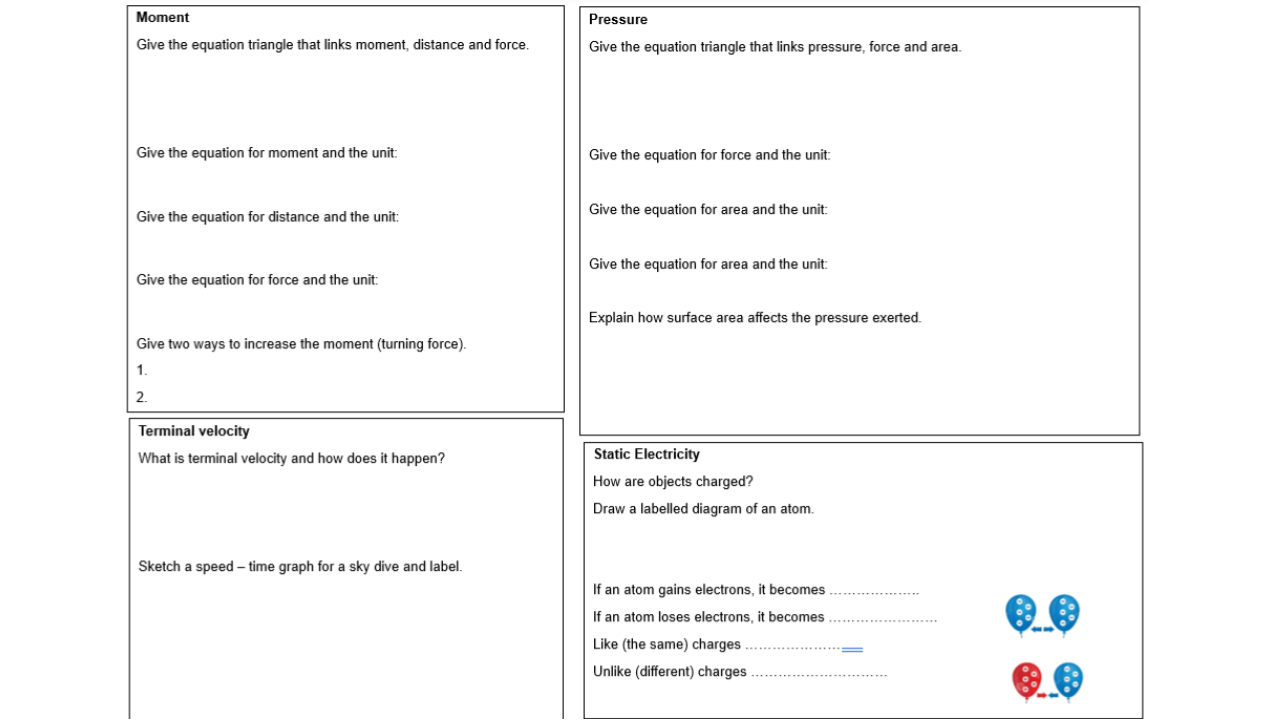Give the equation triangle that links moment, distance and force. Give the equation for moment and the unit. Give the equation for distance and the unit. Give the equation for forc... Give the equation triangle that links moment, distance and force. Give the equation for moment and the unit. Give the equation for distance and the unit. Give the equation for force and the unit. Give two ways to increase the moment (turning force). What is terminal velocity and how does it happen? Sketch a speed-time graph for a sky dive and label. How are objects charged? Draw a labelled diagram of an atom. If an atom gains electrons, it becomes ................. If an atom loses electrons, it becomes ................. Like (the same) charges ............... Unlike (different) charges .................

Understand the Problem
The question encompasses various physics concepts related to moments, pressure, terminal velocity, and static electricity. It asks for equations, definitions, and explanations on these topics, which involve fundamental physical principles.
Answer
Moment = Force × Distance (Nm); Distance (m); Force = Mass × Acceleration (N). Terminal velocity: no net acceleration due to balance of forces. Increase moment: more force, more distance. Charges: electron gain/loss influences charge.
- Moment equation: ( \text{Moment} = \text{Force} \times \text{Distance} ). Unit: Newton-meter (Nm).
- Distance: No specific equation; unit is meter (m).
- Force: ( \text{Force} = \text{Mass} \times \text{Acceleration} ). Unit: Newton (N).
- Increase moment: Increase the force applied or the distance from the pivot.
- Terminal velocity occurs when drag force equals gravitational force, resulting in zero acceleration.
- Objects are charged by gaining or losing electrons.
- If an atom gains electrons, it becomes negatively charged.
- If an atom loses electrons, it becomes positively charged.
- Like charges repel; unlike charges attract.
Answer for screen readers
- Moment equation: ( \text{Moment} = \text{Force} \times \text{Distance} ). Unit: Newton-meter (Nm).
- Distance: No specific equation; unit is meter (m).
- Force: ( \text{Force} = \text{Mass} \times \text{Acceleration} ). Unit: Newton (N).
- Increase moment: Increase the force applied or the distance from the pivot.
- Terminal velocity occurs when drag force equals gravitational force, resulting in zero acceleration.
- Objects are charged by gaining or losing electrons.
- If an atom gains electrons, it becomes negatively charged.
- If an atom loses electrons, it becomes positively charged.
- Like charges repel; unlike charges attract.
More Information
Terminal velocity is crucial in skydiving, where a stable fall happens after accelerating reach a constant speed due to balance of drag and gravity.
Tips
Confusing moment with momentum; moment relates to rotation, while momentum relates to linear motion.
Sources
- Moment Physics - Shiken.ai - shiken.ai
- Turning effect - Moment of a force - BBC - bbc.co.uk
- 6.4 Drag Force and Terminal Speed | University Physics Volume 1 - courses.lumenlearning.com
AI-generated content may contain errors. Please verify critical information